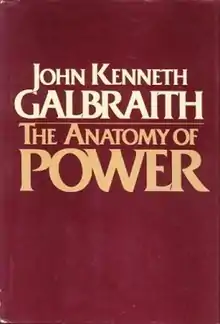The Anatomy of Power
The Anatomy of Power is a book written by Harvard economist John Kenneth Galbraith, originally published in 1983 by Houghton Mifflin Harcourt.[3] It sought to classify three types of power: compensatory power in which submission is bought, condign power in which submission is won by making the alternative sufficiently painful, and conditioned power in which submission is gained by persuasion.[4] In short, money, force and ideology.
 | |
| Author | John Kenneth Galbraith[1] |
|---|---|
| Subject | politics, political science |
| Publisher | Houghton Mifflin Harcourt |
Publication date | 1983[2] |
It further divided power by source: power either stems from personality or leadership, property or wealth, or organisation.
The book goes on to detail a brief history of the use of power, noting the broad arc of history in moving away from condign and towards compensatory and then conditioned power, and from personality and property towards organisation. Finally, it details what Galbraith views as the main sources of power in the modern world: government, the military, religion and the press.
See also
References
- Ingo Swann (2 September 2018). Secrets of Power, Volume I: Individual Empowerment vs the Societal Panorama of Power and Depowerment. Swann-Ryder Productions, LLC. pp. 2–. ISBN 978-1-949214-44-4.
- Yaḥyá Nūrī; Sayed Hassan Amin (January 1987). Legal and Political Structure of an Islamic State: The Implications for Iran and Pakistan. Royston. ISBN 978-0-946706-31-0.
- John Kenneth Galbraith (1983). The Anatomy of Power. Houghton Mifflin. ISBN 978-0-395-34400-2.
- Amar Patnaik (2019). Institutional Change and Power Asymmetry in the Context of Rural India. Springer. pp. 50–. ISBN 9789811313011.